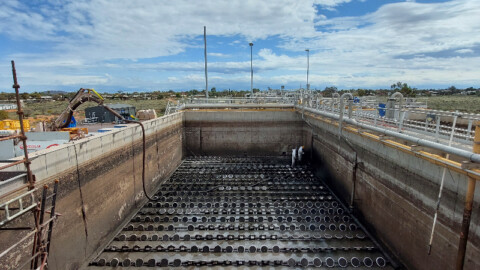Carnegie Clean Energy’s Albany Wave Energy Project (AWEP) is continuing to move forward as it enters into the development phase of it’s CETO 6 unit that will help deliver the project.
The CETO 6 design builds on intellectual property first lodged by Carnegie in 2013 incorporating on-board power generation and multiple moorings and power take off (PTO) modules.
The AWEP involves the design, manufacture and install of a CETO 6 unit in Carnegie’s existing licence area offshore from Torbay and Sandpatch in Albany during the 2019/2020 summer weather window.
The project will also deliver common user infrastructure at the Albany site which Carnegie will make available for other wave energy industry developers once AWEP is complete.
AWEP is supported by $15.75 million from the Western Australian Government’s Department of Primary Industries and Regional Development, and $11.7 million of undrawn funding from Carnegie’s $13 million CETO 6 grant from the Australian Renewable Energy Agency (ARENA).
The past months have seen design progress on the core CETO 6 technology as well as the site-specific design and development for the Albany Wave Energy Project.
Recent site development activities include completion of a metocean modelling study, deployment of an acoustic wave and current meter, ongoing monitoring of the previously deployed wave buoy, local site investigations, studies and surveys, and ongoing stakeholder engagement.
The detailed measurement of the wave resource at the offshore site has been occurring for over two months from the installation of Carnegie’s wave buoy at a site approximately 1.5km offshore from the existing Albany Wind Farm.
The data buoy is deployed in 30m of water depth and is measuring wave height, period and energy spectra, and is transmitting this data to Carnegie’s CETO team.
Upcoming activities on site include geophysical and geotechnical surveys which will help further characterise the deployment site. Good progress has also been made on the cable design, including installation and route options for the cable installation at the AWEP site.
Consultation with specific project stakeholders and engagement with the local supply chain has commenced and local community consultation activities will be undertaken over the next few months.
The CETO 6 design packages for the Albany Wave Energy Project are progressing, along with the ongoing CETO research and development, which includes developing tools and methods to support AWEP as well as undertaking collaborative R&D activities that will feed into future commercial CETO Projects.
The CETO design team has been progressing the CETO Unit architecture design including modelling to establish the optimum physical implementation of the Power Take Off (PTO) inside the Buoyant Actuator to maximise power and facilitate construction for AWEP.
Testing campaigns to validate preferred PTO designs are currently under development. Further design and analysis of the CETO Unit performance has been undertaken across the range of expected sea states at the Albany site to achieve the best Buoyant Actuator (BA) geometry for power production, load optimisation and manufacturing, local logistics and operating costs. This is now incorporating the specific data for the site from the metocean study.
The optimised Buoyant Actuator (BA) geometry will now proceed to wave tank testing at the University of Plymouth in South West England.
















